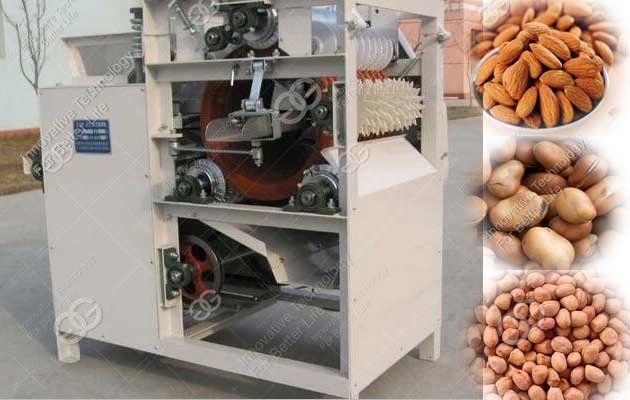Blanched Almond Peanut Peeling Machine
 Katherine /
Katherine /  28 Mar,2017
28 Mar,2017
Application of Blanched Almond Peanut Peeling Machine:

Failure Analysis and Elimination:
| Project | Peanut | Almond | Broad Bean | Soybean |
| Capacity(kg/h) | 200-220 | 200-220 | 300 | 150 |
| Peeling rate(%) | 98±1 | 92-95 | 92-95 | 92±1 |
| Broken rate(%) | 3±1 | 3±1 | 3±1 | 2 |
| Whole kernel rate(%) | 85-95 | 88±2 | 76±2 | - |
| Input Power | 0.75kw(220V, 380V optional) | |||
| Dimensions | Length * width * height=1080×800×1100(mm) | |||

Failure Analysis and Elimination:
| Fault Phenomenon | Failure Cause | Solution |
| Low Peeling Rate | 1.Soak a short time, the water temperature is too low, there are differences between varieties of raw materials | Note the time, adjusting the water temperature |
| 2.Blade damage or blockage on knife around | Replace the blade, cleaning knife around and between the tire skin of bean ,sundries | |
| 3.Feed wheel is too high (skin, rice, beans from the blade too high, do not cut the skin incision) | Reduced feed wheel or knife to adjust the height (distance from the turret tire fixing screws within 4-6mm) | |
| 4.Feed wheel gap is too large or severe tire wear | Transfer a small gap, replacement the rubber wheel | |
| Too many rice, kernels, beans on the skin after peeling | The feed wheel is too high and skin removing roller axis distance is too large | Adjust low the feed wheel, let the skin attached to the shaft squeeze |
| Too many skin on the rice, kernels, beans | The feed wheel is too low,resulting squeeze the skin of the inner shaft left tire |
Adjust high the feed wheel, So crowded leather shaft with rubber tires, the wheels are expected to maintain good contact |
| Rejection does not turn the wheel or damaged skin | Adjustments, changing skin throwing wheel | |
| After installing the chain, dumped skin throw wheel rotation in the wrong direction | Reinstall the chain | |
|
Too much rice,bean without skinning outflow by the bailing tank |
Inconsistent with the induction of broken or induction of induce belt | Replacement or adjustment |
| The size of the raw material | Grading the raw material | |
| Feed tire in contact with the sides of the screen blocking plate is too short | More shifting plate | |
|
High breaking rate after peeling |
The rubber wheel gap is too small | Rising the gap of the rubber wheel |
| Raw soaking time beyond the technological requirements (time too long) | According to the process specified time soaking | |
| Beans thrown from the rubber wheel | Feed rate too large | Reduce the feeding quantity |
| Too slow of the outlet tank and the feeder screen | Feeding screen loose fixtures | Inspection, fixed, repair and replace the gum cover |
| Reversing device fracture | ||
| Severe or too tight pouches worn shock |








